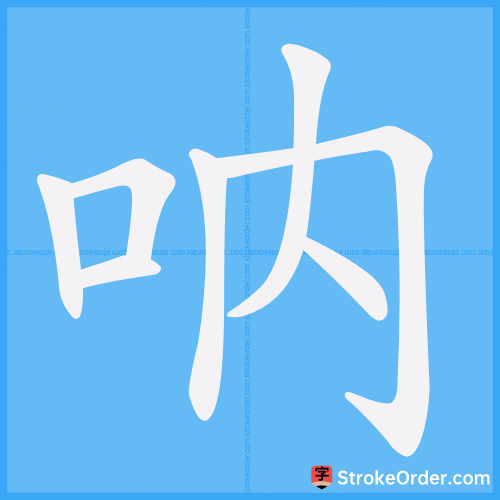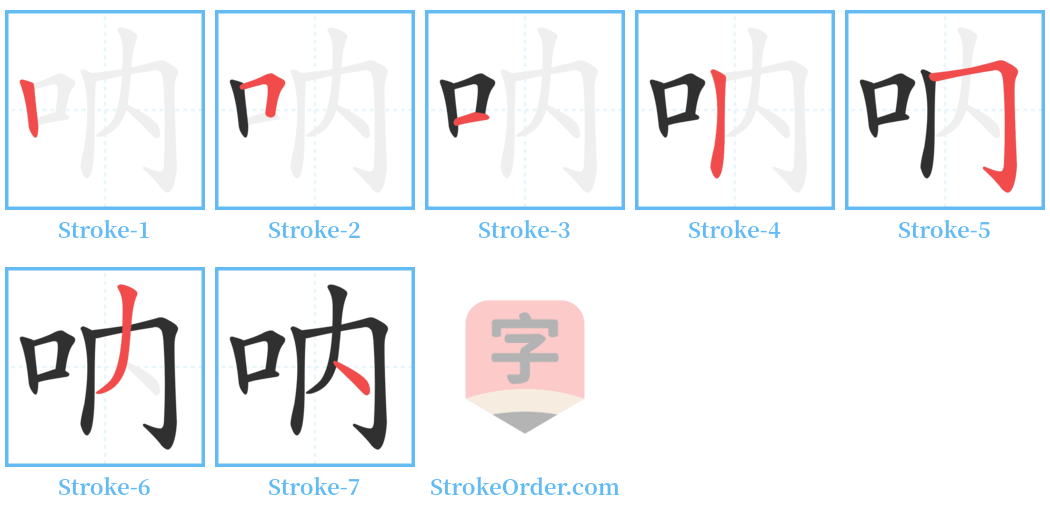呐 Stroke Order
Animated Stroke Order of 呐

Stroke Order Diagrams for 呐

Step-by-Step Handwriting Guide for 呐

Learn to Write Chinese Characters with Video Tutorials
Watch the video of writing the Chinese character "呐", learn the correct stroke order (笔顺) of the character "呐", and master the standard way of writing the character "呐".
Free Printable Handwriting Practice with Stroke Order: 呐
Printable Writing Practice Worksheet of "呐" in Portrait Orientation (Tian Zi Ge)

Printable Writing Practice Worksheet of "呐" in Landscape Orientation (Tian Zi Ge)

Information of 呐
Pinyin
nà、 nè、 ne、 na
Radical
口
Strokes
7 strokes
Usage
★★★★★
Definition
battle cry, (final part.)
呐 [nà]
1. To cry out loudly, as in "shouting encouragement" or "waving flags and shouting."
呐 [nà]
(Verb)
Meaning: To cry out loudly (English: cry out)
引例: In "Water Margin": "At that moment, Shi Jin set fire again in the hall, opened the gate wide, and shouted to kill."
呐 [nà]
(Interjection)
1. Used to remind someone to pay attention (English: mind).
引例: In "Chasing in the Fields" by Ji Xuepei: "Hey, we can start now."
2. See also "nè."
呐 [nè]
1. Historically the same as "讷," meaning slow in speech.
呐 [nè]
(Adjective)
Literal Meaning: Slow in speech or stuttering
Character Formation: Pictophonetic; composed of "口" (mouth) and "内," the latter also serves as the phonetic component. Suggests speech being held up inside the mouth.
引例: 1. "Shuo Wen": "To speak slowly."
2. "Xunzi · Fei Xiang": "His argument was not as good as his speech."
3. "Han Shu · Li Guang Zhuan": "Guang spoke very little."
4. "Han Shu · Bao Xu Chuan": "I, Xuan, am slow with words."
5. "Han Feizi · Ba Jing": "To be slow in speaking."
例: Such as 说呐 (to struggle with speaking), 吃呐 (to stutter), 呐呐 (slow in speech), and 呐钝 (slow-witted in language).
呐 [nè]
(Verb)
1. To speak softly (English: whisper; speak in a low voice)
引例: In "Water Margin": "I only heard a faint whisper of 'Gao Taiwei' coming from the mouth."
2. See also "nà."
suona, Chinese shawm (oboe), used in festivals and processions or for military purposes / also written 鎖吶|锁呐 / also called 喇叭[la3 ba5]
Input Method for 呐
Pinyin
na4
Wubi
kmwy
Cangjie
rob
Zhengma
jlod
Four Corner
64027
Unicode
U+5450
Same Pronunciation Characters